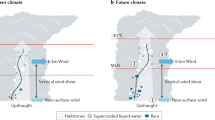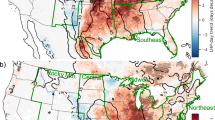Abstract
Anthropogenic climate change is anticipated to increase severe thunderstorm potential in North America, but the resulting changes in associated convective hazards are not well known. Here, using a novel modelling approach, we investigate the spatiotemporal changes in hail frequency and size between the present (1971–2000) and future (2041–2070). Although fewer hail days are expected over most areas in the future, an increase in the mean hail size is projected, with fewer small hail events and a shift toward a more frequent occurrence of larger hail. This leads to an anticipated increase in hail damage potential over most southern regions in spring, retreating to the higher latitudes (that is, north of 50° N) and the Rocky Mountains in the summer. In contrast, a dramatic decrease in hail frequency and damage potential is predicted over eastern and southeastern regions in spring and summer due to a significant increase in melting that mitigates gains in hail size from increased buoyancy.
This is a preview of subscription content, access via your institution
Access options
Access Nature and 54 other Nature Portfolio journals
Get Nature+, our best-value online-access subscription
$29.99 / 30 days
cancel any time
Subscribe to this journal
Receive 12 print issues and online access
$209.00 per year
only $17.42 per issue
Buy this article
- Purchase on Springer Link
- Instant access to full article PDF
Prices may be subject to local taxes which are calculated during checkout





Similar content being viewed by others
References
Dessens, J. Severe convective weather in the context of nighttime global warming. Geophys. Res. Lett. 22, 1241–1244 (1995).
Del Genio, A. D., Yao, M. S. & Jonas, J. Will moist convection be stronger in a warmer climate? Geophys. Res. Lett. 34, L16703 (2007).
Trapp, R. J. et al. Changes in severe thunderstorm frequency during the 21st century due to anthropogenically enhanced global radiative forcing. Proc. Natl Acad. Sci. USA 104, 19719–19723 (2007).
Trapp, R. J., Diffenbaugh, N. S. & Gluhovsky, A. Transient response of severe thunderstorm forcing to elevated greenhouse gas concentrations. Geophys. Res. Lett. 36, L01703 (2009).
Van Klooster, S. L. & Roebber, P. J. Surface-based convective potential in the contiguous United States in a business-as-usual future climate. J. Clim. 22, 3317–3330 (2009).
Brooks, H. E. Severe thunderstorms and climate change. Atmos. Res. 123, 129–138 (2013).
Diffenbaugh, N. S., Scherer, M. & Trapp, R. J. Robust increases in severe thunderstorm environments in response to greenhouse forcing. Proc. Natl Acad. Sci. USA 101, 16361–16366 (2013).
Gensini, V. A., Ramseyer, C. & Mote, T. L. Future convective environments using NARCCAP. Int. J. Climatol. 34, 1699–1705 (2014).
Gensini, V. A. & Mote, T. L. Downscaled estimates of late 21st century severe weather from ccsm3. Climatic Change 129, 307–321 (2015).
Seeley, J. T. & Romps, D. M. The effect of global warming on severe thunderstorms in the United States. J. Clim. 28, 2443–2458 (2015).
Paquin, D., de Elía, R. & Frigon, A. Change in North American atmospheric conditions associated with deep convection and severe weather using CRCM4 climate projections. Atmosphere 52, 175–190 (2014).
Tippett, M., Allen, J. T., Gensini, V. A. & Brooks, H. E. Climate and hazardous convective weather. Curr. Clim. Change Rep. 1, 60–73 (2015).
Mohr, S., Kunz, M. & Keuler, K. Development and application of a logistic model to estimate the past and future hail potential in Germany. J. Geophys. Res. 120, 3939–3956 (2015).
Jewell, R. & Brimelow, J. C. Evaluation of Alberta hail growth model using severe hail proximity soundings from the United States. Weath. Forecast. 24, 1592–1609 (2009).
in Managing the Risks of Extreme Events and Disasters to Advance Climate Change Adaptation (eds Field, C. B. et al.) 582 (IPCC, Cambridge Univ. Press, 2012).
National Academies of Sciences, Engineering, and Medicine Attribution of Extreme Weather Events in the Context of Climate Change (National Academies, 2016).
Ilotoviz, E., Khain, A. P., Benmoshe, N., Phillips, V. T. J. & Ryzhkov, A. V. Effect of aerosols on freezing drops, hail, and precipitation in a midlatitude storm. J. Atmos. Sci. 73, 109–144 (2016).
Loftus, A. M., Cotton, W. R. & Carrió, G. G. A triple moment hail bulk microphysics scheme. Part 1: Description and initial evaluation. Atmos. Res. 149, 35–57 (2014).
Allen, J. T., Tippett, M. K. & Sobel, A. H. An empirical model relating US monthly hail occurrence to large-scale meteorological environment. J. Adv. Model. Earth Syst. 7, 226–243 (2015).
Kapsch, M. L., Kunz, M., Vitolo, R. & Economou, T. Long-term variability of hail-related weather types in an ensemble of regional climate models. J. Geophys. Res. 117, D15 107 (2012).
Botzen, W. J. W., Bouwer, L. M. & van den Bergh, J. C. J. M. Climate change and hailstorm damage: empirical evidence and implications for agriculture and insurance. Resour. Energy Econ. 32, 341–362 (2010).
Trapp, R. J. & Hoogewind, K. A. The realization of extreme tornadic storm events under future anthropogenic climate change. J. Clim. 29, 5251–5265 (2016).
Mohr, S. & Kunz, M. Recent trends and variabilities of convective parameters relevant for hail events in Germany and Europe. Atmos. Res. 123, 211–228 (2013).
Leslie, L. M., Leplastrier, M. & Buckley, B. W. Estimating future trends in severe hailstorms over the Sydney Basin: a climate modelling study. Atmos. Res. 87, 37–51 (2008).
Sanderson, M. et al. Projected changes in hailstorms during the 21st century over the UK. Int. J. Climatol. 35, 15–24 (2014).
Niall, S. & Walsh, K. The impact of climate change on hailstorms in Southeastern Australia. Int. J. Climatol. 25, 1933–1952 (2005).
Mahoney, K., Alexander, M. A., Thompson, G., Barsugli, J. J. & Scott, J. D. Changes in hail and flood risk in high-resolution simulations over Colorado’s mountains. Nat. Clim. Change 2, 125–131 (2012).
Mearns, L. O. et al. The North American regional climate change assessment program: overview of phase I results. Bull. Am. Meteorol. Soc. 93, 1337–1362 (2012).
Brimelow, J. C., Reuter, G. W. & Poolman, E. R. Modeling maximum hail size in Alberta thunderstorms. Weath. Forecast. 17, 1048–1062 (2002).
A Special Report on Emissions Scenarios (eds Nakićenović, N. & Swart, R.) 599 (Cambridge Univ. Press, 2000).
Etkin, D. & Brun, S. E. A note on Canada’s hail climatology: 1977–1993. Int. J. Climatol. 19, 1357–1373 (1999).
Xie, B., Zhang, Q. & Wang, Y. Observed characteristics of hail size in four regions in China during 1980–2005. J. Clim. 23, 4973–4982 (2010).
Rasmussen, R. M. & Heymsfield, A. J. Melting and shedding of graupel and hail. Part I: model physics. J. Atmos. Sci. 44, 2754–2763 (1987).
Doswell, C. A. III, Brooks, H. E. & Kay, M. P. Climatological estimates of daily local nontornadic severe thunderstorm probability for the United States. Weath. Forecast. 20, 577–595 (2005).
Allen, J. T. & Tippett, M. K. The characteristics of United States hail reports: 1955–2014. Electron. J. Severe Storms Meteorol. 10, 1–31 (2015).
Dessens, J., Berthet, C. & Sanchez, J. L. Change in hailstone size distributions with an increase in the melting level height. Atmos. Res. 158, 245–253 (2015).
Eccel, E., Cau, P., Riemann-Campe, K. & Biasioli, F. Quantitative hail monitoring in an alpine area: 35-year climatology and links with atmospheric variables. Int. J. Climatol. 32, 503–517 (2011).
Giorgi, F., Jones, C. & Asrar, G. R. Addressing climate information needs at the regional level: the CORDEX framework. World Meteorol. Organ. Bull. 58, 175–183 (2009).
Orville, R. E., Huffines, G. R., Burrows, W. R. & Cummins, K. L. The North American Lightning Detection Network (NALDN)—analysis of flash data: 2001–09. Mon. Weath. Rev. 139, 1305–1322 (2011).
Cecil, D. J. & Blankenship, C. B. Toward a global climatology of severe hailstorms as estimated by satellite passive microwave imagers. J. Clim. 25, 687–703 (2012).
Cintineo, J. L., Smith, T. M., Lakshmanan, V., Brooks, H. E. & Ortega, K. L. An objective high-resolution hail climatology of the contiguous United States. Weath. Forecast. 27, 1235–1248 (2012).
Ferraro, R., Beauchamp, J., Cecil, D. & Heymsfield, G. A prototype hail detection algorithm and hail climatology developed with the advanced microwave sounding unit (AMSU). Atmos. Res. 163, 24–35 (2015).
Sanderson, M. G., Hemming, D. L. & Betts, R. A. Regional temperature and precipitation changes under high-end (≥ 4 °C) global warming. Phil. Trans. R. Soc. A 369, 85–98 (2011).
Guinard, K., Mailhot, A. & Caya, D. Projected changes in characteristics of precipitation spatial structures over North America. Int. J. Climatol. 35, 596–612 (2015).
Brimelow, J. C. & Reuter, G. W. Explicit forecasts of hail occurrence and expected hail size using the GEM–HAILCAST system with a rainfall filter. Weath. Forecast. 24, 935–945 (2009).
Strong, G. & Lozowski, E. P. An Alberta study to objectively measure hailfall intensity. Atmosphere 15, 33–53 (1977).
Heymsfield, A. J., Giammanco, I. M. & Wright, R. The terminal velocities and kinetic energies of natural hailstones. Geophys. Res. Lett. 41, 8666–8672 (2014).
Dessens, J. & Fraile, R. Hailstone size distributions in southwestern France. Atmos. Res. 33, 57–73 (1994).
Mielke, P. W. Jr, Berry, K. J. & Brier, G. W. Application of multi-response permutation procedures for examining seasonal changes in monthly mean sea-level pressure patterns. Mon. Weath. Rev. 109, 120–126 (1981).
Acknowledgements
We acknowledge the Changing Cold Regions Network (CCRN) and the Natural Sciences and Engineering Research Council (NSERC) of Canada for their financial support. We are grateful to the North American Regional Climate Change Assessment Program (NARCCAP) for making the model data freely available and particularly to S. McGinnis for his assistance in obtaining the NARCCAP data. Finally, we are indebted to the following individuals: B. Bonsal, N. Taylor, G. Gascon, N. Sharp, A. Pankratz and S. Kehler.
Author information
Authors and Affiliations
Contributions
J.M.H., J.C.B. and W.R.B. conceived and designed the experiments. W.R.B. and J.C.B. analysed the data, and W.R.B. performed the experiments. J.C.B. wrote the paper and created the figures; W.R.B. and J.M.H. contributed to the interpretation of the data analyses and editing of the paper.
Corresponding author
Ethics declarations
Competing interests
The authors declare no competing financial interests.
Supplementary information
Supplementary Information
Supplementary Information (PDF 3481 kb)
Rights and permissions
About this article
Cite this article
Brimelow, J., Burrows, W. & Hanesiak, J. The changing hail threat over North America in response to anthropogenic climate change. Nature Clim Change 7, 516–522 (2017). https://doi.org/10.1038/nclimate3321
Received:
Accepted:
Published:
Issue Date:
DOI: https://doi.org/10.1038/nclimate3321
This article is cited by
-
Hails in Ny Alesund, Svalbard-atmospheric vertical structure and dependence on circulation
Natural Hazards (2023)
-
Hailstorms over India during the summer season
Meteorology and Atmospheric Physics (2023)
-
Management of hailstorms under a changing climate in agriculture: a review
Environmental Chemistry Letters (2022)
-
Spatio-temporal analysis of precipitation pattern and trend using standardized precipitation index and Mann–Kendall test in coastal Andhra Pradesh
Modeling Earth Systems and Environment (2022)
-
The effects of climate change on hailstorms
Nature Reviews Earth & Environment (2021)



